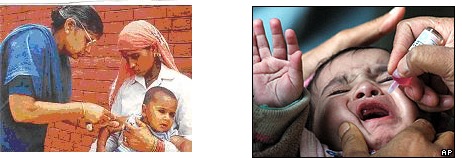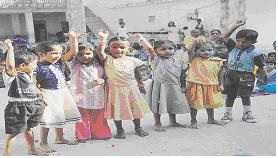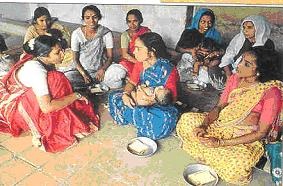Integrated Child Development Services (ICDS) Scheme
Launched on 2nd October 1975, today, ICDS Scheme represents one of the world’s largest and most unique programmes for early childhood development. ICDS is the foremost symbol of India’s commitment to her children – India’s response to the challenge of providing pre-school education on one hand and breaking the vicious cycle of malnutrition, morbidity, reduced learning capacity and mortality, on the other.
Objectives
The Integrated Child Development Services (ICDS) Scheme was launched in 1975 with the following objectives:
- To improve the nutritional and health status of children in the age-group 0-6 years;
- To lay the foundation for proper psychological, physical and social development of the child;
- To reduce the incidence of mortality, morbidity, malnutrition and school dropout;
- To achieve effective co-ordination of policy and implementation amongst the various departments to promote child development; and to enhance the capability of the mother to look after the normal health and nutritional needs of the child through proper nutrition and health education.
Services
The above objectives are sought to be achieved through a package of services comprising:
- Supplementary nutrition
- Immunization
- Health check-up
- Referral services
- Pre-school non-formal education and
- Nutrition and health education
The concept of providing a package of services is based primarily on the consideration that the overall impact will be much larger if the different services develop in an integrated manner as the efficacy of a particular service depends upon the support it receives from related services.
|
Services |
Target Group |
Service Provided by |
|
Supplementary Nutrition |
Children below 6 years: |
Anganwadi Worker and Anganwadi Helper |
|
Immunization* |
Children below 6 years: |
ANM/MO |
|
Health Check-up* |
Children below 6 years: |
ANM/MO/AWW |
|
Referral Services |
Children below 6 years: |
AWW/ANM/MO |
|
Pre-School Education |
Children 3-6 years |
AWW |
|
Nutrition and Health Education |
Women (15-45 years) |
AWW/ANM/MO |
Three of the six services namely Immunisation, Health Check-up and Referral Services delivered through Public Health Infrastructure under the Ministry of Health and Family Welfare.
2.1 Nutrition including Supplementary Nutrition: This includes supplementary feeding and growth monitoring; and prophylaxis against vitamin A deficiency and control of nutritional anaemia. All families in the community are surveyed, to identify children below the age of six and pregnant and nursing mothers. They avail of supplementary feeding support for 300 days in a year. By providing supplementary feeding, the Anganwadi attempts to bridge the caloric gap between the national recommended and average intake of children and women in low income and disadvantaged communities.
Growth Monitoring and nutrition surveillance are two important activities that are undertaken. Children below the age of three years of age are weighed once a month and children 3-6 years of age are weighed quarterly. Weight-for-age growth cards are maintained for all children below six years. This helps to detect growth faltering and helps in assessing nutritional status. Besides, severely malnourished children are given special supplementary feeding and referred to medical services.
2.2 Immunization: Immunization of pregnant women and infants protects children from six vaccine preventable diseases-poliomyelitis, diphtheria, pertussis, tetanus, tuberculosis and measles. These are major preventable causes of child mortality, disability, morbidity and related malnutrition. Immunization of pregnant women against tetanus also reduces maternal and neonatal mortality.

2.3 Health Check-ups: This includes health care of children less than six years of age, antenatal care of expectant mothers and postnatal care of nursing mothers. The various health services provided for children by anganwadi workers and Primary Health Centre (PHC) staff, include regular health check-ups, recording of weight, immunization, management of malnutrition, treatment of diarrhoea, de-worming and distribution of simple medicines etc.
2.4 Referral Services: During health check-ups and growth monitoring, sick or malnourished children, in need of prompt medical attention, are referred to the Primary Health Centre or its sub-centre. The anganwadi worker has also been oriented to detect disabilities in young children. She enlists all such cases in a special register and refers them to the medical officer of the Primary Health Centre/ Sub-centre.
2.5 Non-formal Pre-School Education (PSE)

The Non-formal Pre-school Education (PSE) component of the ICDS may well be considered the backbone of the ICDS programme, since all its services essentially converge at the anganwadi – a village courtyard. Anganwadi Centre (AWC) – a village courtyard – is the main platform for delivering of these services. These AWCs have been set up in every village in the country. In pursuance of its commitment to the cause of India’s Children, present government has decided to set up an AWC in every human habitation/ settlement. As a result, total number of AWC would go up to almost 1.4 million. This is also the most joyful play-way daily activity, visibly sustained for three hours a day. It brings and keeps young children at the anganwadi centre - an activity that motivates parents and communities. PSE, as envisaged in the ICDS, focuses on total development of the child, in the age up to six years, mainly from the underprivileged groups. Its programme for the three-to six years old children in the anganwadi is directed towards providing and ensuring a natural, joyful and stimulating environment, with emphasis on necessary inputs for optimal growth and development. The early learning component of the ICDS is a significant input for providing a sound foundation for cumulative lifelong learning and development. It also contributes to the universalization of primary education, by providing to the child the necessary preparation for primary schooling and offering substitute care to younger siblings, thus freeing the older ones – especially girls – to attend school.
2.6 Nutrition and Health Education:

Nutrition, Health and Education (NHED) is a key element of the work of the anganwadi worker. This forms part of BCC (Behaviour Change Communication) strategy. This has the long term goal of capacity-building of women – especially in the age group of 15-45 years – so that they can look after their own health, nutrition and development needs as well as that of their children and families.
Funding Pattern
- ICDS is a Centrally-sponsored Scheme implemented through the State Governments/UT Administrations. Prior to 2005-06, 100% financial assistance for inputs other than supplementary nutrition, which the States were to provided out of their own resources, was being provided by the Government of India. Since many States were not providing adequately for supplementary nutrition in view of resource constraints, it was decided in 2005-06 to support to States up to 50% of the financial norms or to support 50% of expenditure incurred by them on supplementary nutrition, whichever is less.
- From the financial year 2009-10, Government of India has modified the funding pattern of ICDS between Centre and States. The sharing pattern of supplementary nutrition in respect of North-eastern States between Centre and States has been changed from 50:50 to 90:10 ratio. So far as other States and UTs, the existing sharing pattern of 50:50 continues. However, for all other components of ICDS, the ratio has been modified to 90:10(100% Central Assistance earlier.
ICDS Training Programme:
Training and capacity building is the most crucial element in the ICDS Scheme, as the achievement of the programme goals largely depends upon the effectiveness of frontline workers in improving service delivery under the programme. Since inception of the ICDS scheme, the Government of India has formulated a comprehensive training strategy for the ICDS functionaries. Training under ICDS scheme is a continuous programme and is implemented through 35 States/UTs and National Institute of Public Cooperation and Child Development (NIPCCD) and its four regional centres.
During the 11th Five Year Plan, the Government of India has laid much emphasis on strengthening the training component of ICDS in order to improve the service delivery mechanism and accelerate better programme outcomes. An allocation of Rs. 500 crore has been kept for the ICDS Training Programme during the 11th Five Year Plan.
Financial norms relating to training of various ICDS functionaries and trainers have been revised upwardly with effect from 1 April 2009.
-
Types of Training Courses: Three types of regular training are imparted to AWWs, AWHs, Supervisors, CDPOs/ACDPOs and Instructors of AWTCs and MLTCs, viz.:
-
Induction Training (on initial engagement/appointment) mainly to AWWs
-
Job/Orientation Training (once during service period)
-
Refresher Training (in-service, once in every two years)
Also, specific need based training programmes are organized under the ‘Other Training’ component, whereby the States/UTs are given flexibility to identify state specific problems that need specialized issue based training and take up such training activities.
-
Training Infrastructure: There is a countrywide infrastructure for the training of ICDS functionaries, viz.
-
Anganwadi Workers Training Centres (AWTCs) for the training of Anganwadi Workers and Helpers.
-
Middle Level Training Centres (MLTCs) for the training of Supervisors and Trainers of AWTCs;
-
National Institute of Public Cooperation and Child Development (NIPCCD) and its Regional Centres for training of CDPOs/ACDPOs and Trainers of MLTCs. NIPCCD also conducts several skill development training programmes.
[Govt. of Tamil Nadu has established a State Training Institute (STI) at the State level for the training of Trainers of MLTCs and CDPOs/ACDPOs]
Based on the needs, State Governments identify and open up AWTCs and MLTCs after due approval by the Government of India. As on 31.3.2009, 490 AWTCs and 31 MLTCs were operational across the country. About 80% of the AWTCs and 70% MLTCs are run by State/District based NGOs.
Monitoring and Supervision of Training Programme: A separate ICDS Training Unit within the Ministry of Women and Child Development headed by a Director/Dy. Secretary level officer is responsible for overall monitoring, supervision and evaluation of the training programme. The following measures are undertaken for monitoring and supervision:
-
Physical and financial progress are captured through Quarterly Progress Reports (QPRs) in a standardized format, that are submitted by the States/UTs to GoI at the end of every quarter;
-
A detailed analysis of the QPRs is carried out by the ICDS Training Unit and based on the same, quarterly review meetings are organized with the States at the central level;
-
Monthly/quarterly review meeting with the Training Centres at the state level;
-
Necessary feedback and guidelines are issued to the States after each of the review meetings;
-
Field visits to AWTCs/MLTCs by Nodal Officer or the District Programme Officers (DPOs)/CDPOs; and also by the officials from the Ministry of WCD and NIPCCD.
-
Annual meeting of State Training Task Force (STTF) for the approval of STRAP and review of past performance and chalking out future actions.
Recent Initiatives: The Ministry has recently initiated a process of consultations with the States and other stakeholders to review and identify gaps in the existing training system and make suggestions to strengthen the ICDS Training programme including its contents/syllabi, training methodology and the existing monitoring mechanism under ICDS training programme. Three regional workshops have since been organized in collaboration with NIPCCD and with technical support from USAID/CARE INDIA during July-August 2009 at three Regional centres of NIPCCD at Bangalore, Lucknow and Guwahati.
Existing Monitoring System under ICDS Scheme:
Central Level
Ministry of Women and Child Development (MWCD) has the overall responsibility of monitoring the ICDS scheme. There exists a Central Level ICDS Monitoring Unit in the Ministry which is responsible for collection and analysis of the periodic work reports received from the States in the prescribed formats. States have been asked to send the State level consolidated reports by 17th day of the following month.
The existing status of monitoring of these six services is as under:
(i) Supplementary Nutrition: No. of Beneficiaries (Children 6 months to 6 years and pregnant and lactating mothers) for supplementary nutrition;
(ii) Pre-School Education : No. of Beneficiaries (Children 3-6 years) attending pre-school education;
(iii) Immunization, Health Check-up and Referral services : Ministry of Health and Family Welfare is responsible for monitoring on health indicators relating to immunization, health check-up and referrals services under the Scheme.
(iv)Nutrition and Health Education
This service is not monitored at the Central Level. State Governments are required to monitor up to State level in the existing MIS System.
(v) No. of ICDS Projects and Anganwadi Centres (AWCs) w.r.t. targeted no. of ICDS Projects and AWCs are taken into account for review purpose.
Analysis and Action
The information received in the prescribed formats is compiled, processed and analysed at the Central level on quarterly basis. The progress and shortfalls indicated in the reports on ICDS are reviewed by the Ministry with the State Governments regularly by review meetings/ letters.
State Level
Various quantitative inputs captured through CDPO’s MPR/ HPR are compiled at the State level for all Projects in the State. No technical staff has been sanctioned for the state for programme monitoring. CDPO’s MPR capture information on number of beneficiaries for supplementary nutrition, pre-school education, field visit to AWCs by ICDS functionaries like Supervisors, CDPO/ ACDPO etc., information on number of meeting on nutrition and health education (NHED) and vacancy position of ICDS functionaries etc.
Block Level
At block level, Child Development Project Officer (CDPO) is the in-charge of an ICDS Project. CDPO’s MPR and HPR have been prescribed at block level,. These CDPO’s MPR/ HPR formats have one-to-one correspondence with AWW’s MPR/ HPR. CDPO’s MPR consists vacancy position of ICDS functionaries at block and AWC levels. At block level, no technical post of officials have been sanctioned under the scheme for monitoring. However, one post of statistical Assistant./ Assistant is sanctioned at block level to consolidate the MPR/ HPR data.
In between CDPO and AWW, there exist a supervisor who is required to supervise 25 AWC on an average.
CDPO is required to send the Monthly Progress Report (MPR) by 7th day of the following month to State Government. Similarly, CDPO is required to send Half-yearly Progress Report (HPR) to State by 7th April and 7th October every year.
Village Level (Anganwadi Level)
At the grass-root level, delivery of various services to target groups is given at the Anganwadi Centre (AWC). An AWC is managed by an honorary Anganwadi Worker (AWW) and an honorary Anganwadi Helper (AWH).
In the existing Management Information System, records and registers are prescribed at the Anganwadi level i.e. at village level. The Monthly and Half-yearly Progress Reports of Anganwadi Worker have also been prescribed. The monthly progress report of AWW capture information on population details, births and deaths of children, maternal deaths, no. of children attended AWC for supplementary nutrition and pre-school education, nutritional status of children by weight for age, information on nutrition and health education and home visits by AWW. Similarly, AWW’s Half yearly Progress Report capture data on literacy standard of AWW, training details of AWW, increase/ decrease in weight of children, details on space for storing ration at AWC, availability of health cards, availability of registers, availability of growth charts etc.
AWW is required to send these Monthly Progress Report (MPR) by 5th day of following month to CDPO’ In-charge of an ICDS Project. Similarly, AWW is required to send Half-yearly Progress Report (HPR) to CDPO by 5th April and 5th October every year.

